Returning to mainland Europe for the first time in six years, developers, contractors and occupiers gathered to discuss the future of the office. Daniel Gayne runs through some of the main discussion points from the three-day conference

It has been a while since the British Council for Offices’ (BCO) annual conference made its way across the channel for three days in continental Europe. If you said the word “coronavirus” to one of the delegates to Copenhagen in 2019, they might have pulled a funny face. In 2025, and only just starting to get used to the changes brought to their sector by the pandemic, more than 600 BCO members descended on Milan to discuss what comes next for offices
Here are �ڶ�����’s key takeaways from the three-day conference:
A ‘city of gates’ and a model for office-led regeneration
In her speech opening the conference, Helen Hare, BCO senior vice-president and conference chair, said that for most of the attendees, the answer to the question “why Milan?” was simple: “Why not?”.
But for the organisers, she said, bringing the conference to the pricey commercial juggernaut of northern Italy had been a longstanding ambition. On its third time trying, Hare said they had finally managed to bring the British office sector to the city of fashion.
“In planning for the conference, and in a world of change, I wanted to take the conference to a location where the BCO had not been before, but also somewhere I felt we had something to learn and experience,” said Hare. “I wanted a location that was vibrant and supported the next most significant asset that drives real estate, and that is us and our people.
“Milan is the financial and economic hub and powerhouse of Italy. It is also the centre of design and fashion. It has placed itself on the global map as a destination of choice, and it is a city undergoing major transformation with some of the most prestigious urban regeneration projects in Europe.”
Hare was followed by a native Milanese, Carlo Alberto Carnevale Maffe, who gave a verbal tour of the city’s history and all that makes it great, delivered in flamboyant style and at machine-gun pace (he got through 92 slides in 45 minutes). Maffe, an associate professor of practice of strategy and entrepreneurship at SFA Bocconi School of Management, explained how Milan was “not a city of walls, but a city of gates”; a city of technology and learning, where academia and commerce combine over coffee, and where even a genius such as Leonardo da Vinci had to bring his CV to get a gig.
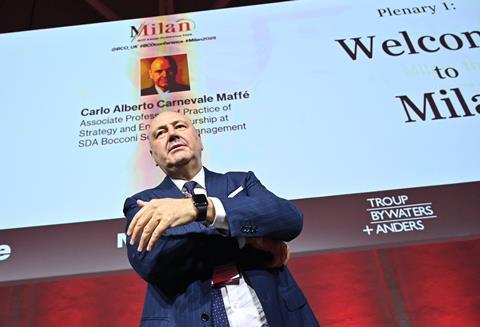
The city, he said, had “reinvented itself many times”, most recently through the 2015 Milan Expo and the development of Porta Nuova. The city had been willing to rip-up tradition in order to progress, he added.
The Expo, for instance, triggered the abandonment of a centuries-old provision that no structure would be built taller than the Madonnina. Through this, it had managed to set itself apart from the rest of Italy, with GDP growth (9.9%) almost double that of the rest of the country, low employment and a high level of patent production and globally-cited scientific research.
Offering advice to British office developers, Maffe urged them to learn from Milan’s embrace of work as a central part of life. “The opposition between work and life, we don’t buy it,” he said.
Later that day, Manfredi Catella, founder and chief executive of Coima, the developer responsible for much of the Porta Nuova and Olympic development [the winter Olympics will be based here in February next year], explained just how significant the mid-2010s had been for Milan. “When we started Porta Nuova, it was a very low moment in the reputation and quality from a design perspective,” he said, explaining how there had been “a cultural deterioration in the country” in the 20th century.
“We transitioned a bad reputation to a good reputation” through the project, Catella explained, helping to make Milan an attractive prospect for investors.
Speaking to �ڶ����� at the end of the second day, Hare said the UK could learn from Milan’s positive attitude to growth and sympathetic planning system. “You really get the sense that the local authority is working with developers to push and drive that growth,” she said, noting that there were commercial incentives for hitting renewable targets built into the city’s system, not just punishments for failing to meet standards.
The office is ‘very much alive’ – but only three days a week
“I think it’s fair to say the office is very much alive.” Hare’s statement at the start of the conference struck a more confident tone than has generally been taken in the office sector in recent years. She reeled off headlines from recent weeks describing how central London rental ERVS are 7-9% up in the past 12 months and grade A space is in short supply.
Indeed, there was a sense of renewed optimism in conversations over espresso or Aperol across the three days of the conference. Knight Frank surveyor Betsy Brady said there had been a shift in sentiment since MIPIM in March.
“Before that, the sentiment with capital markets was feeling OK, [but] we were waiting for the change to come,” she said. “But then, when I was at was at MIPIM and I was speaking to so many developers and investors who were like, ‘ well, let’s just get in now. You know, we can keep waiting, or we can get moving now’.”
Helena Morris, senior development director at Stanhope, agreed that the mood was now “really positive”, adding that the upturn seemed to be happening sooner than expected. “I think we always said 2025 will be when we start to feel more positive,” she said. “We didn’t think it would be at a super-early point in 2025, [but] I think that’s now what we are seeing.”
Not everyone painted quite such a rosy picture, however. Mark Lacey, director at Turner & Townsend Alinea, said there was “more confidence” in the market but that viability was still a “massive challenge” because of the cost of funding.
“I think the market is starting to turn, and the evidence of that is you see private equity come back into the market, and we’re seeing lots of clients trying to acquire sites and get things going,” he said, but stressed that this came with an asterix.
“Until the public spending review washes through, until the cost of money comes down, I don’t think you’re gonna see that sentiment dramatically change,” he said, adding that, with President Trump causing chaos in the American economy, “everything is so uncertain”.
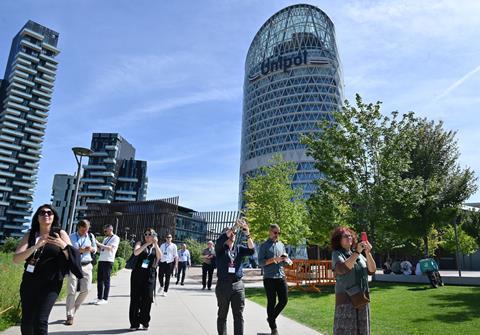
The improved investment picture perhaps reflects the stabilisation of occupancy following years of uncertainty after the pandemic. There seems to be a consensus that, between Tuesday and Thursday, office working has returned to roughly its pre-pandemic norm. But developers and occupiers are still trying to figure out how to deal with Mondays and the even more troublesome Fridays.
Office developers have thrown the kitchen sink at amenity in recent years to attract people back into work. But, according to Morris, there is an increasing realisation of the need to answer employees’ basic question: “is your workplace more comfortable than your home set-up?”
In a panel discussion on the future of the workplace, Dr Nigel Osland, of Workplace Unlimited, noted: “The office is really good for [connectivity] but for some people, they still need those areas of concentration and focus as well.”
While occupiers have by no means given up on getting staff back in at the end of the week, there is also a recognition that this could be a new normal that requires adaptation. “There are a number of occupiers that have strategies in place where, on these days, you can occupy floors here, and then on Monday and Friday, they will specifically close off floors … to minimise electricity expenditure and all of the facilities being used,” noted Brady.
In a seminar session chaired by Brady, another method for utilising space fully was mentioned. David Crew, head of corporate real estate at Hogan Lovells mentioned that his firm opened up its ofice on Friday for some of their key clients to use. Those responsible for designing new workspaces are realising that the best thing they can do is to offer adaptable spaces to accommodate this fluctuating picture.
“The key thing we’ve seen over the last few years is we can’t predict the future,” said Simon Wyatt, partner at Cundall. “What we see the trend towards, at the moment, is more adaptable spaces,” he says, explaining that clients are looking for additional MEP capacity and spaces that can easily be reconfigured.
Low carbon agenda to enhance engineer’s role, and change the face of the City
Given the changing geopolitical winds worldwide, you might wonder whether the industry might have dropped its sustainability ambitions. But, if that is going to be the case, it has not happened yet. Michela Martini, technical director at WSP, said that “ultimately there is only one direction” on sustainability, and that is reducing waste and making buildings more operationally efficient.
“The simple answer is ‘ no’, we’re not feeling the effect,” agreed Austin Wikner, partner, Ridge. “I think the probably more nuanced answer is that you will start to see some of that effect come through.”
For now, though, Wikner is focused on dealing with the “whole raft of new legislation” coming in over the next 18 months “that will affect us up until at least 2030”. This includes a new UK Net Zero Carbon �ڶ����� Standard, which will come out in September and give a full definition of a net zero carbon building, as well as the new Future �ڶ����� Standard, which will bring “very significant change to where we currently sit in terms of energy efficiency” when it comes in next April.
According to Wikner, the new standard will mean more focus on passive design, electric heating solutions, high u values in facades, insulation and air tightness. “All of that is heading towards tightening up the minimum energy efficiency standard,” he said, suggesting that there would probably be an expectation of EPC C by 2027 and an EPC B by 2030.
“Effectively, that means that people have buildings today that will struggle to achieve the right EPC ratings that then allows them to be leased. So you are heading towards clients having portfolio buildings or individual buildings that effectively could become stranded.”
Wikner said that the new regulations could push changes in the way that tall office buildings in the UK are designed, with the classic glass curtain walling facing “the greatest challenge”, because of the embodied carbon involved. Smith agreed in part, explaining that there was “a big balancing act with the facade”.
22 Bishopsgate, for instance, was built with a very efficient facade from an operational perspective, “but that’s because its got layer upon layer of glazing”, as well as blinds with motors. “I can say operationally this is a very efficient facade, but my embodied carbon spend on material to deliver that really outweighs it,” he says.
T&T Alinea’s Mark Lacey said he did not expect “the death of the glass building”, explaining that they could be sustainable if designed correctly. “The whole focus needs to move away from embodied carbon and chasing minutiae, [instead] focusing on operational efficiency,” he said, adding that he expected to see an increase in building on top of existing stock in the City.
Pushing boundaries: BCO NextGen’s wall of ideas
BCO NextGen, the organisation’s programme devoted to under 35s in the sector, had a noticeably more prominent role at this year’s conference. According to Oliver Hall, national chair of the group, NextGen members now make up almost a third of the BCO’s membership, as well as more than 100 of the delegates in Milan.
Hall, who is also a partner at Make Architects, said that, while “in the past, NextGen has always been seen as a bit of an add-on”, this year they had been given “free rein”. They used this blank cheque to host a no-holds-barred brainstorm about “the BCO in 2030”.
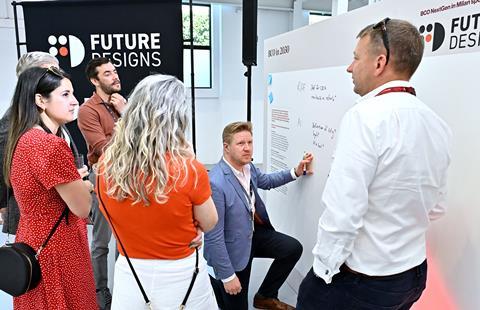
“You imagine that everyone’s going to have such disparate ideas. But there was huge number of themes that came through data and access to data was quite obvious,” said Hall, suggesting that the BCO could facilitate information sharing on a number of key metrics.
“Occupancy rates in certain areas, how quick you can get planning through on a certain type of building, how many people you need to deliver on projects – things like that.”
Another topic which was the subject of heated discussion was the wastefulness of developers stripping out Cat A fit-out work. Victoria Caines, an associate director (MEP) at Turner & Townsend Alinea who attended the session, told �ڶ����� afterwards: “I think everyone is really frustrated about working on a project, seeing Cat A installed and then next week you see it in a skip.”
Some suggested that there could be incentives for occupiers not to bin Cat A fit-out or whether the BCO should lobby the government to set new standards.
Another blue sky thought was permitted development for offices, while some attendees even wondered whether the BCO should change its name to better reflect its contemporary role.
According to Wikner, designers will not be pushed away from or in favour of a single solution, but rather be forced into experimentation. “The period of, say, maybe 2010, after 2020, building design was interesting, but it was all very similar,” he said. “The architects did a really great job of making things look different, [but] peel away the skin and it’s all very, very similar. We’re all going to have to explore pretty hard.”
One thing most people agreed on was that the carbon agenda would drive towards a greater volume of refurbishment work compared with new-build, with even relatively recently built towers requiring work. “We’re working with the client now to decarbonise a building that’s only five years old,” said Smith.
“The old BCO office criteria from 15 years ago doesn’t work anymore. It was all about over-provision and giving the tenant what they want […] the market has moved so much.”
The increasing importance of building incredibly efficient buildings is also enhancing the role of the MEP engineer, according to Sam Smith, technical director at WSP. He says his team was recently, for the first time, appointed by the client before the architect was chosen.
“We sat there with a client and had to write a brief and sit on the interview panel,” he said. “This is a big shift. I mean, 10 years ago, we would come in, the architect would go and sell the dream and go and make it all work, and say, ‘ find an engineer to fit some boxes in’.”
Not only will the engineer’s role begin earlier, it could also stretch on for longer as owners seek to improve operational efficiency, with engineers kept on to monitor and make adjustments. “We don’t say at practical completion, ‘ thanks very much for your services’, we work with you for three, five, or seven years, and then off you go into the sunset,” according to Stanhope’s Morris. “Now we retain certain parts of the engineers to do that.”
Smith agreed that, while “in the past there was definitely a hard stop, where you just walk away”, things were now changing.
New leadership heralds new era for the BCO
This conference marked a momentous changing of the guard at the BCO as the first in more than two decades not to take place under the leadership of long-time chief executive Richard Kauntze. During his 25 years in the role, Kauntze has seen BCO conferences in 17 cities across the UK, US and Europe, and overseen a growth in membership from 585 to more than 4,000.
At the beginning of proceedings in Milan, Helen Hare praised Kauntze for having “guided the ship” through “many challenging times”, including the global financial crisis and covid. “Throughout that time, the membership has continued to grow, research technical papers have continued plenty, and the BCO awards have become an aspiration for most of us in the sector,” said Hare.
>> Read more: ‘We’re too self effacing’: BCO chief Richard Kauntze on why UK offices are some of the best in the world
Kauntze was replaced at the beginning of this month by Samantha McClary, a former editor of the publication Estates Gazette, making the transition from “critical friend” of the industry to would-be sector leader. In a sit-down conversation with Hare, she said that, as a journalist, she “fell in love with real estate” and that she eventually decided that she “wanted to be more of a champion”.
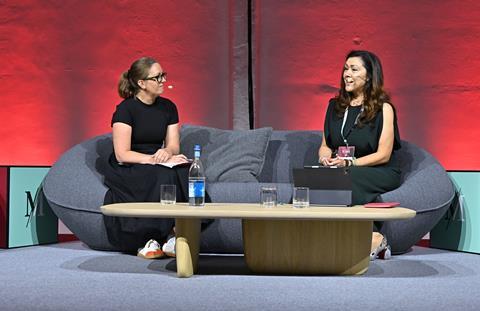
Asked what she saw as being the biggest challenges for the sector going forward, McClary picked “complacency”. She said the industry no longer had the “luxury” to simply “get used to how things are done” without innovating.
“We need that caffeine shot clearly to make sure that we’re pushing forwards all the time,” she continued. “I think, if we’re not, we’re not moving, we’re not running, we’re not pivoting when we need to pivot, then that’s a that’s a real danger.”
Speaking to �ڶ�����, Mark Lacey, who curated the conference programme, praised the work McClary had already done, saying that what she was trying to achieve with [the BCOI] being “much more of a mouthpiece for the office industry is absolutely right”. He said that the Milan conference had been the start of “a bit of a recalibration” of the BCO, with more women and young people organising and presenting.
Where next?
After three days of networking and discussion, all that was left was the grand reveal. Andy McBain, head of future of workspace and design at NatWest Group and junior vice-president of the BCO, announced in the final plenary session that the 2026 event will take place in Edinburgh.
“Just as the Scottish Enlightenment sparked a revolution in thinking across the arts, architecture, science, medicine, philosophy and economics, today’s workplace is undergoing its very own profound transformation and it’s very own enlightenment,” said McBain.
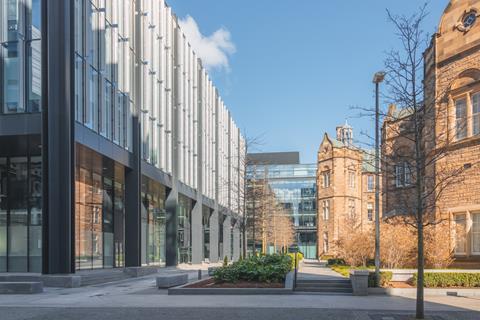
But, there is a twist. Some of the programme will take place in another city – Glasgow.
McBain listed the two cities’ successes as cities of innovation: penicillin, Dolly the sheep and the digestive biscuit for Edinburgh; ultrasound, waterproof coats and the chicken tikka masala for Glasgow.
“We’ll provide the festival, the gathering and the party and we ask you to bring your expertise and creative energy so together we can spark the debates, discussions and the new enlightenment,” he said.
We might add that �ڶ����� will once again provide the key takeaways.
�ڶ����� is the media partner for this year’s BCO conference




















No comments yet